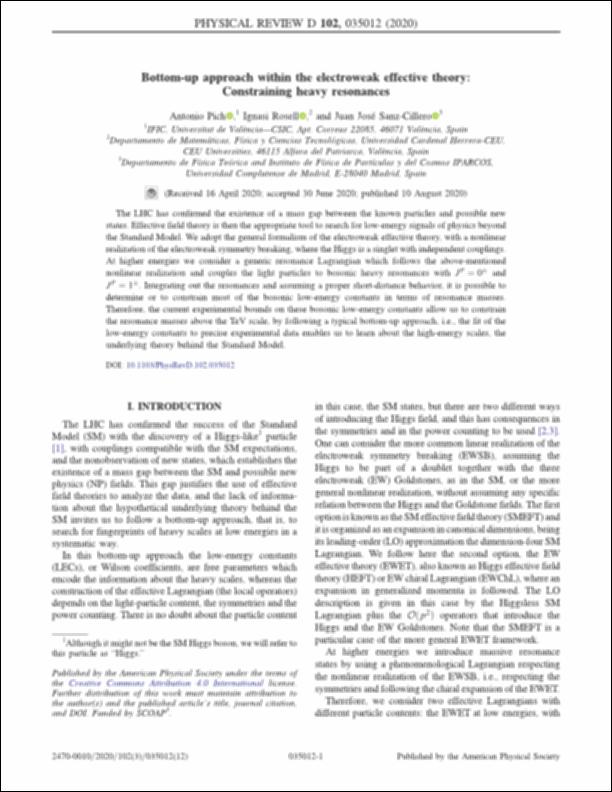Por favor, use este identificador para citar o enlazar este ítem:
http://hdl.handle.net/10637/12733Bottom-up approach within the electroweak effective theory : constraining heavy resonances
| Título : | Bottom-up approach within the electroweak effective theory : constraining heavy resonances |
| Autor : | Pich Zardoya, Antonio Rosell Escribá, Ignasi Sanz Cillero, Juan José |
| Materias: | Particles (Nuclear physics); Colisiones (Física nuclear); Materia - Propiedades.; Collisions (Nuclear physics); Partículas (Física nuclear); Matter - Properties. |
| Editorial : | American Physical Society. |
| Citación : | Pich, A., Rosell, I. and Sanz-Cillero, J.J. (2020). Bottom-up approach within the electroweak effective theory : constraining heavy resonances. Physical Review D, vol. 102, n. 3, art. 035012 (10 aug.). DOI: https://doi.org/10.1103/PhysRevD.102.035012 |
| Resumen : | The LHC has confirmed the existence of a mass gap between the known particles and possible new states. Effective field theory is then the appropriate tool to search for low-energy signals of physics beyond the Standard Model. We adopt the general formalism of the electroweak effective theory, with a nonlinear realization of the electroweak symmetry breaking, where the Higgs is a singlet with independent couplings. At higher energies we consider a generic resonance Lagrangian which follows the above-mentioned nonlinear realization and couples the light particles to bosonic heavy resonances with JP ¼ 0 and JP ¼ 1 . Integrating out the resonances and assuming a proper short-distance behavior, it is possible to determine or to constrain most of the bosonic low-energy constants in terms of resonance masses. Therefore, the current experimental bounds on these bosonic low-energy constants allow us to constrain the resonance masses above the TeV scale, by following a typical bottom-up approach, i.e., the fit of the low-energy constants to precise experimental data enables us to learn about the high-energy scales, the underlying theory behind the Standard Model. |
| Descripción : | Este artículo se encuentra disponible en la siguiente URL: https://journals.aps.org/prd/abstract/10.1103/PhysRevD.102.035012 |
| URI : | http://hdl.handle.net/10637/12733 |
| Derechos: | http://creativecommons.org/licenses/by/4.0/deed.es |
| ISSN : | 2470-0010. 2470-0029 (Electrónico). |
| Fecha de publicación : | 10-ago-2020 |
| Centro : | Universidad Cardenal Herrera-CEU |
| Aparece en las colecciones: | Dpto. Matemáticas, Física y Ciencias Tecnológicas |
Los ítems de DSpace están protegidos por copyright, con todos los derechos reservados, a menos que se indique lo contrario.


